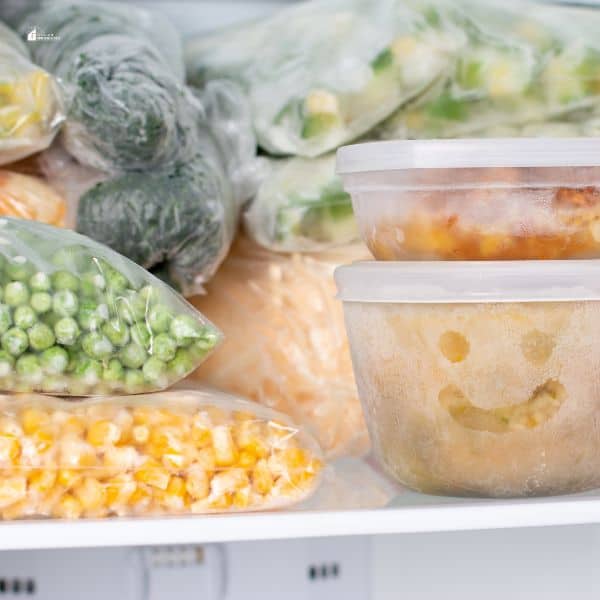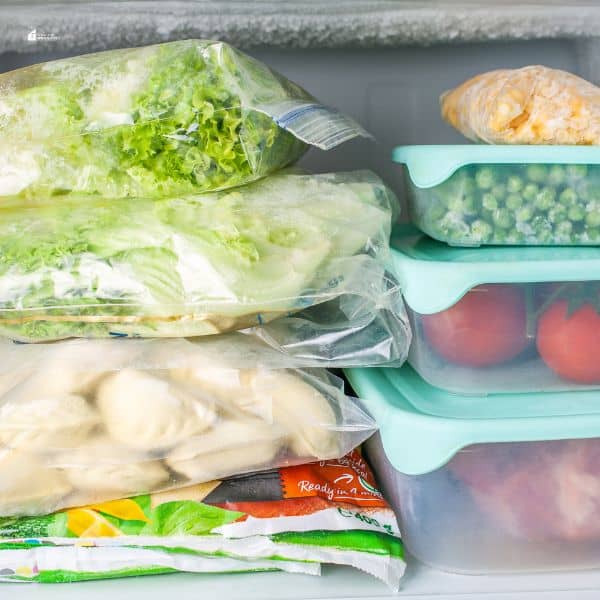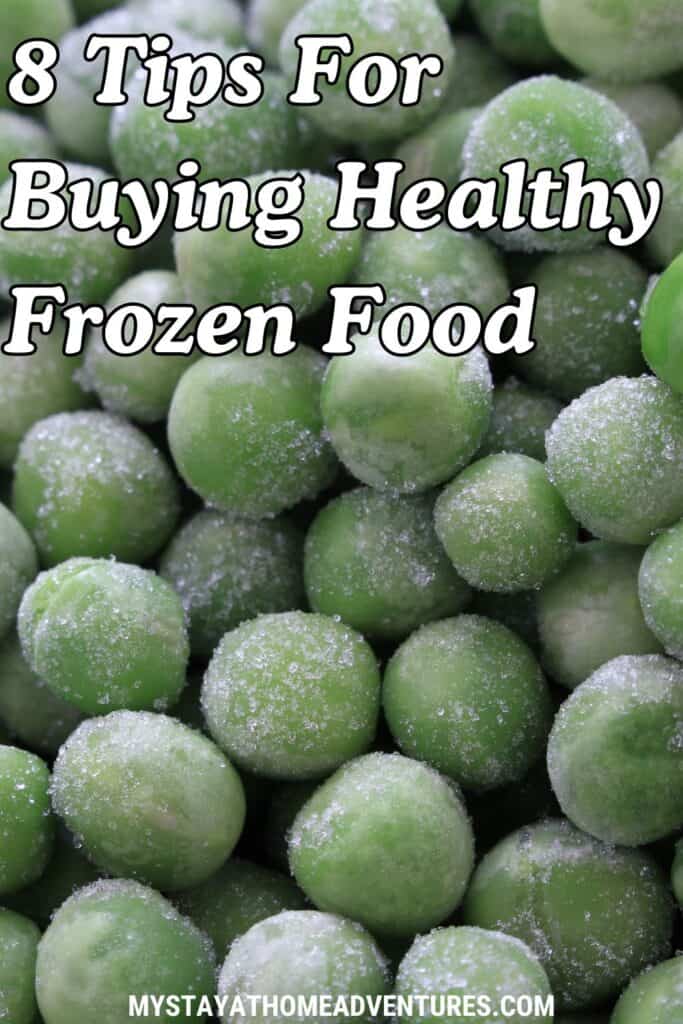8 Tips For Buying Healthy Frozen Food (You Might Not Know About)
This post may contain affiliate links which might earn us money. Please read my Disclosure and Privacy policies hereHey there! March is Frozen Food Month, so let's celebrate by debunking a common myth: that all frozen foods are unhealthy. It's just not true, friends! Some freezer aisles are packed with sodium-rich, overpriced meals, but plenty of nutritious options exist.
Frozen food can be delicious and good for you—if you know what to look for! Join me as I share tips and tricks I've learned to help you make the healthiest frozen food choices. We'll discuss everything from the benefits of 100% pure vegetables to why you should avoid pre-seasoned meats.
Ready to become a savvier frozen food shopper? Let's dive in!
Frozen food consumption has seen a significant uptick in the United States in recent years. According to the American Frozen Food Institute, sales of frozen foods reached $65.1 billion in 2020, indicating a surge in popularity amidst a growing recognition of their convenience and nutritional value.
This increase reflects a broader shift in consumer behavior, as more Americans are reaching for frozen fruits and vegetables, which saw sales growths of 21% and 20%, respectively. This trend underscores a changing perception among consumers who now acknowledge frozen foods' role in a balanced, healthy diet.

Benefits of Frozen Fruits and Vegetables
Contrary to popular belief, frozen fruits and vegetables can often be more nutritious than their fresh counterparts. This is because they are typically picked at the peak of ripeness and flash frozen, locking in their nutritional value. In contrast, fresh produce can lose some of its nutrients during transportation and storage.
Additionally, frozen fruits and vegetables are incredibly convenient. They require no peeling, chopping, or washing, making them a great time-saving option for busy individuals. Plus, they have a longer shelf life than fresh produce, reducing food waste and saving you money.
What To Look For When Buying Healthy Frozen Food
As a general rule, the fewer the ingredients, the better. When browsing through frozen food options, be mindful of added sugars, preservatives, and sodium levels. Look for products that are made with whole ingredients and avoid heavily processed items.
Another important factor to consider is the nutritional value of your chosen frozen meals. Make sure to check the nutrition label for information on calories, fat, and protein content. Aim for meals that provide a good balance of nutrients and avoid those high in unhealthy fats or lacking in essential vitamins and minerals.
Why You Should Avoid Pre-Seasoned Meats
While frozen meats can be a great source of protein, it's important to choose wisely. Many pre-seasoned meats are loaded with sodium and preservatives, making them less healthy than their unseasoned counterparts. Instead, opt for plain frozen meats and add your own seasonings or marinade for a healthier and more flavorful meal.

Choosing the Best Frozen Meats
When it comes to selecting the best-frozen meats to incorporate into your diet without falling into the trap of buying pre-seasoned options, here are a few tips to keep in mind:
- Opt for unprocessed meats: Look for frozen meat that hasn't been processed or altered in any significant way. Whole cuts of meat like chicken breasts, thighs, ground beef, or fish fillets are excellent choices. These options offer flexibility in preparation and seasoning, allowing you to control your sodium and preservative intake.
- Check the packaging for added ingredients: Even when meats are not pre-seasoned, they can still contain added water or solutions intended to preserve freshness. Read the labels carefully to ensure that you're buying meat that is as close to its natural state as possible.
- Consider sustainability and sourcing: Whenever possible, choose meats that are sustainably sourced and ethically raised. While this information might not be as prominent on packaging, brands committed to these practices often highlight their methods. This can also be a marker of higher quality and better taste.
- Explore a variety of options: Don't limit yourself to just one type of meat. The frozen section offers a range of options, from turkey and duck to more exotic meats like bison or venison. Experimenting with different types can introduce new flavors and textures to your meals, all while keeping your diet diverse and interesting.
By following these tips, you can make healthier choices in the frozen food aisle, ensuring that your meals are nutritious, delicious, and free from unnecessary additives.
Check the frozen vegetable ingredients.
When choosing frozen vegetables, be sure to check the ingredients list. Some frozen vegetable options may contain added sauces or seasonings that can increase the overall sodium and calorie content. Stick to plain frozen vegetables or choose ones with minimal added ingredients.
Double-check your frozen food storage.
Double-check for lumps before purchasing your frozen food. If there are, it indicates that the product was thawed and refrozen again. When this happens, there's a greater chance that the product will retain fewer nutrients.
Storing frozen foods is crucial for maintaining their quality and nutritional value. Be sure to keep your freezer at 0 degrees Fahrenheit or lower and avoid leaving the freezer door open for extended periods. Additionally, rotate older items to the front of your freezer and use them before newer purchases to prevent food waste.

Avoid buying vegetables with cheese or any other sauce.
While frozen vegetables with added sauces or cheese may be convenient, they are often high in calories, sodium, and unhealthy fats. Instead, choose plain frozen vegetables and add your own toppings or sauces to control your meal's ingredients and nutritional value.
Instead, please look for frozen vegetables with limited ingredients and seasonings that you can add yourself. Doing so allows you to customize your meal to suit your dietary needs and preferences, making it a healthier and more enjoyable option.
Check serving size and portion control.
Understanding serving size is crucial when purchasing frozen food because it allows you to accurately assess the nutritional content and ensure that you're consuming a balanced meal.
Misjudging serving sizes can lead to overeating or consuming more calories and sodium than intended. To make healthier choices, start by examining the serving size listed on the nutrition label. Compare it to the total contents of the package to determine if the meal serves one, two, or more.
Here are some tips on what to look for regarding serving size:
- Check the Serving Size on the Label: Always compare the serving size on the label to the total servings in the package. Some packages may look like a single serving but contain two or more servings, doubling or tripling the calorie and nutrient intake you might have assumed.
- Portion Control: If a package contains multiple servings, consider dividing it into the recommended serving sizes immediately after cooking. This prevents overeating and helps with portion control.
- Nutritional Value per Serving: Assess the nutrition facts per serving, not just per package. This provides a clearer understanding of what you're actually consuming in a single sitting.
- Visual Cues for Serving Size: Familiarize yourself with visual cues for common serving sizes (e.g., a cup of vegetables is about the size of a tennis ball). This can help when serving meals to ensure proper portion sizes.
- Adjust According to Dietary Needs: Remember, the recommended serving size on the package may not align with your specific dietary needs. Adjust portions based on your personal health goals or dietary restrictions.
By paying attention to serving sizes and adjusting portions accordingly, you can enjoy frozen food's convenience and benefits without compromising your nutritional goals.

Avoid fruits with sweeteners.
Avoiding frozen fruits with added sweeteners is crucial for anyone looking to maintain a healthy diet, manage weight, or regulate blood sugar levels. Added sweeteners can significantly increase the calorie content of fruits and lead to unnecessary sugar intake, negating the natural health benefits of the fruit itself. Consuming too much-added sugar can also contribute to a range of health issues, including obesity, type 2 diabetes, and heart disease.
When shopping for frozen fruits, it's important to check the ingredients list carefully to identify if sweeteners have been added. Look for keywords such as “sugar,” “high fructose corn syrup,” “cane sugar,” “corn syrup,” “dextrose,” or any other terms that indicate the presence of added sweeteners.
Opting for plain frozen fruits without any added ingredients ensures you get the fruit's natural flavor and nutritional benefits without the added sugars' negative effects. This way, you can enjoy the sweetness of your favorite fruits and still maintain a balanced and healthful diet.
Purchase frozen food with low sodium.
Choosing frozen food with low sodium levels is crucial due to the profound impact of excessive sodium intake on our health. Sodium, commonly found in high quantities in many processed and frozen foods, can lead to increased blood pressure, which is a leading risk factor for heart disease and stroke. For individuals who are sensitive to sodium, such as those with hypertension, heart conditions, or kidney problems, it's especially important to monitor and limit sodium intake.
Furthermore, most people consume far more sodium than the recommended daily limit, largely due to processed foods. By opting for low-sodium frozen options, individuals can significantly reduce their overall sodium intake without sacrificing the convenience and enjoyment of frozen meals. This approach not only helps in managing and preventing chronic health conditions but also promotes a balanced diet.
Therefore, when navigating the frozen food aisle, making a conscious effort to select products labeled as “low sodium” or “no added salt” can be a simple yet effective step towards better health.

Understanding What “Healthy” Means on Frozen Food Packaging
When browsing the frozen food section, you may come across products labeled as “healthy,” but what does that really mean? Unfortunately, there is no set definition or standard for using the term “healthy” on food packaging. Manufacturers may use this label loosely to appeal to health-conscious consumers without adhering to specific nutritional guidelines.
To ensure that a frozen food product is genuinely healthy, it's important to look beyond the flashy label and examine the nutrition facts and ingredients list. Look for whole, natural ingredients with minimal processing and limited additives or preservatives. Avoid products with high amounts of unhealthy fats, added sugars, and sodium.
Also, consider the meal's overall nutritional value in terms of protein, fiber, vitamins, and minerals. By closely examining the nutrition facts and ingredients list, you can make informed decisions and select truly healthy frozen food options.
In summary, making smart choices in the frozen food aisle requires a bit of diligence and knowledge about what to look for. By focusing on serving sizes, avoiding added sweeteners and high sodium content, and understanding the true meaning of “healthy” labels, you can enjoy the benefits of convenience without compromising your health goals.
Always remember to read labels carefully, opt for options closest to their natural state, and adjust your selections based on your dietary needs. Incorporating these tactics into your shopping routine can lead to better nutritional choices, enabling you to enjoy the variety and ease of frozen foods while maintaining a balanced and healthful diet.








5 Comments